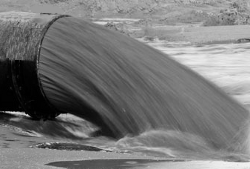Slurry Transports - Minimum Flow Velocities
Flow velocities in slurry transport systems to avoid settling of solids.

A suspension of solid particles in a liquid, as in a mixture of cement, clay, coal dust, manure, meat, etc. - with water is often called a slurry.
In transport systems for slurries it's important to avoid settling of solids by keeping the fluid velocities in the pipe lines above certain levels. The levels depends primary on the type and size of the solid in the slurry:
| Type of Solids | Size of Solids (Mesh No) | Minimum Flow Velocity | |
|---|---|---|---|
| m/s | ft/s | ||
| Fine | over 200 | 1 – 1.5 | 3 – 5 |
| Sand | 200 – 20 | 1.5 – 2 | 5 – 7 |
| Coarse | 20 – 4 | 2 – 3.25 | 7 – 11 |
| Sludge | 0.6 - 3 | 2 - 9 | |
A pipeline transport system may under certain circumstances be nearly self cleaning. When a solid settle the pipe area decrease - and fluid speed increase - until a state of equilibrium where the speed is so high that settling is avoided.
Sludges with solid content less than 2 percent have hydraulic characteristics similar to water. For solids contents greater than 2 percent the friction losses are from 1.5 - 4 times the friction losses for water.
The speed should be increased in lifting lines by decreasing the piping diameter. At the end of a pipeline the speed should be slowed down by increasing the pipeline diameter.
Mesh definition
- Mesh is the number of openings per inch of a screen - "a 100 mesh screen"
- Mesh is often used to measures the size of particles - "100 mesh powdered sand"
Slope and Self Cleaning
The required slope for self cleaning of sludge pipe lines can be estimated as
Smin = τmin / (ρ Rh) (1)
where
Smin = minimum slope for self cleaning (m/m)
τmin = required shear stress for self cleaning (kg/m2) - (0.25 kg/m2 for slugde waste water, 0.15 kg/m2 for rain water)
ρ = density of fluid (kg/m3)
Rh = hydraulic diameter at maximum flow (m)



